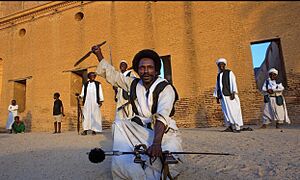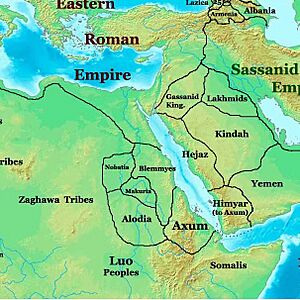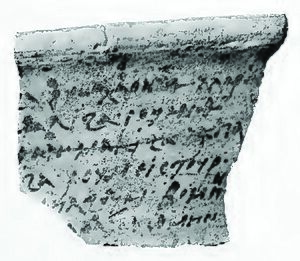Blemmyes facts for kids
The Blemmyes were an ancient group of people. They lived in the Eastern Desert of Africa. We know about them from writings between 700 BC and 800 AD. By the late 300s AD, they had taken over Lower Nubia. This area is in modern-day Sudan and Egypt. They even set up their own kingdom there.
We learned a lot about their kingdom from writings. These writings were found in the temple of Isis at Philae. Many experts believe the Blemmyes were part of the X-Group culture. This culture was important in the late ancient period. It's also widely thought that the Blemmyes are related to the Beja people. The Beja people have lived in the same area since the Middle Ages.

Contents
Who Were the Blemmyes?
Around 1000 BC, a group called the C-group moved. They went from Lower Nubia to Upper Nubia. This is the Nile Valley area in Sudan. There, they built the kingdom of Napata around 750 BC. For a while, this kingdom even ruled Egypt.
At the same time, another group lived there. Archaeologists call them "pan-grave people." They are thought to be the Medjay from old writings. Most of these people were nomads. They moved around the desert with their animals. They raised donkeys, sheep, and goats.
After 600 BC, the Napatan kingdom lost control. They lost Egypt and Lower Nubia. Lower Nubia became mostly empty for about 400 years. This was because the area became very dry. Farming near the Nile River became hard. The Nile's water level dropped a lot. It only got better when the saqiyah waterwheel was invented. This happened around 1 AD. Until then, only a few desert nomads lived there. It was a dangerous place for travelers.
Blemmyes Through History
The Blemmyes might have been mentioned in Egyptian texts. These texts date back to the 600s BC. The Greek name "Blemmyes" first appeared around 200 BC. The writer Eratosthenes described them. He said they lived between the Nile and the Red Sea.
Later, Strabo wrote about them. He said they were nomadic raiders. But he also said they were not very warlike. Some later writers described the Blemmyes in strange ways. Pliny the Elder even said they were headless! He wrote that their faces were on their chests.
The Blemmyes became very strong. In 193 AD, a Roman leader asked a Blemmye king for help. This was for a battle against the Roman Emperor. In 250 AD, the Roman Emperor Decius fought them. He worked hard to defeat their invading army.
A few years later, in 253 AD, they attacked Egypt again. But they were quickly defeated. In 265 AD, they lost another battle to the Romans. Later, in 273 AD, they helped a Roman rebel. They also joined forces with the Palmyrans against the Romans. This was during the Battle of Palmyra 273.
The Roman general Marcus Aurelius Probus fought them. He defeated the rebels and their allies. But he could not stop the Blemmyes from taking over parts of Egypt. This led to another war. The Blemmyes army was almost completely destroyed around 279–280 AD.
During the rule of Emperor Diocletian, the Blemmyes again took over parts of Egypt. In 298 AD, Diocletian made peace with them. He also made peace with the Nobatae tribe. Rome agreed to move its border north to Philae. This is in southern Egypt. Rome also agreed to pay the two tribes gold every year.
What Language Did They Speak?
Many researchers believe the Blemmyes' language was an early form of modern Beja. A scholar named Francis Llewellyn Griffith found an ancient pot shard. He thought the writing on it was in the Blemmye language.
Other experts, like Gerald Michael Browne and Klaus Wedekind, agreed. They tried to show that this language was an ancestor of Beja. They even thought it was a piece of a Bible psalm.
An Egyptologist named Helmut Satzinger also studied Blemmye names. He found them in Egyptian, Greek, and Coptic writings. He also concluded that the Blemmye language was an ancestor of Beja.
Another expert, Claude Rilly, agrees. He said the Blemmyan language is very similar to modern Beja. He thinks it might just be an old dialect of the same language. This means the Blemmyes could be a special tribe of the Medjay.
Blemmyes Culture
The Blemmyes lived in a large area in what is now Sudan. They had several important cities. These included Faras, Kalabsha, Ballana, and Aniba. All these cities had strong walls and towers. These buildings mixed Egyptian, Greek, Roman, and Nubian styles.
Kalabsha was the capital city of the Blemmyes. Their culture was also shaped by the Meroitic culture. Their religion was important in the temples of Kalabsha and Philae.
The Kalabsha temple was a huge building. They worshipped a lion-like sun god there named Mandulis. Philae was a place where many people went to worship. It had temples for Isis, Mandulis, and Anhur. Roman Emperors like Augustus and Trajan added many new temples and plazas there.
Their Religion
We learn most about the Blemmyes' religion from temple writings. These are found in Philae and Kalabsha. We also learn from Roman and Egyptian stories. They worshipped Isis at Philae. Mandulis was worshipped at Kalabsha. They also had groups that worshipped other gods. These gods included Abene, Amati, and Khopan.
Some old writings say the Blemmyes also worshipped Osiris and Priapus. One writer, Procopius, even claimed the Blemmyes sacrificed humans to the sun.
Letters from the early 500s AD suggest something else. Some Blemmyes may have become Christians.
{{Wide image|The Meroitic ("Ethiopian") chamber of the temple of Philae.jpg|880px|Pictures inside the Isis temple of Philae. They show travelers and priests from the south.]]
The Blemmyan Kingdom
Both Blemmye writings and Roman records mention their leaders. They used terms that mean "kings." Because of this, people often say the Blemmyes had a kingdom. But some historians are not so sure. They think there might not have been one big kingdom. Instead, there might have been several smaller tribal groups. These groups might have worked together.
Blemmye writings talk about different royal officials. They seemed to have a system of leaders. Below the kings were "phylarchs." These were like chiefs of separate tribes. Other officials included sub-chiefs, court officials, and scribes. The Blemmye kings had the power to collect taxes. They could also decide who didn't have to pay taxes. They also had power over their land.
Here are some of the Blemmye kings we know about:
- Tamal (early 4th or 5th century)
- Isemne
- Degou
- Phonen (around 450 AD)
- Pokatimne
- Kharakhen
- Barakhia




